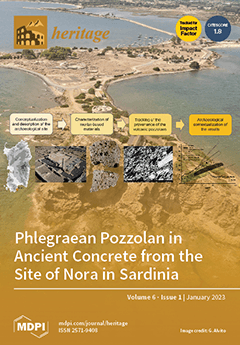The traditional shirt (“
ie”) is the most well-known element of Romanian anonymous textile art. Apart from aesthetic and utilitarian roles, it has strong symbolic significance, mainly through the colours used for decoration. Very recently, the traditional shirt with decoration over the
[...] Read more.
The traditional shirt (“
ie”) is the most well-known element of Romanian anonymous textile art. Apart from aesthetic and utilitarian roles, it has strong symbolic significance, mainly through the colours used for decoration. Very recently, the traditional shirt with decoration over the shoulder (“
ia cu altiță”) was introduced as a Romanian identity element as part of UNESCO heritage. Depending on the ethnographic area, the traditional shirt with decoration over the shoulder has acquired special expressive particularities over time. Particularly relevant is that from Valea Hârtibaciului, an area of Transylvania in the very centre of Romania. Although sober in appearance with large fields of white plain weave, it is discreetly decorated with elaborated embroidery on the sleeve bracelets, over the shoulders and neck. Even the colour range and decoration motifs remain unchanged in time, evolution in the materials used and a subtle transition from natural hues to more strident alternatives were observed in the late 19th and early 20th centuries. For the present study, samples were taken from representative objects in the collections of the ASTRA Museum, Sibiu and Ethnographical Museum, Brasov, documented as belonging to the area of Valea Hârtibaciului and dated in the museum archives as from the late 19th and early 20th century. The textile materials and the dyes used in the shirts’ embroidery were monitored. Fibre identification was made by optical microscopy and infrared spectroscopy (FTIR-ATR). Dye analysis was performed by liquid chromatography coupled with UV-Vis (diode array) detection, while some of the samples were also analysed by liquid chromatography coupled with mass spectrometric detection (LC-DAD-MS). Dyes were extracted from the fibres by acid hydrolysis. Identification was based on data collected on standards, dyes and dyed fibres. For the early synthetic dyes, a dedicated library of references was built, which includes information relative to the most relevant representatives used between 1850 and 1900, the ‘Helmut Schweppe list’. According to the study, in the last decades of the 19th century, natural dye sources such as dyer’s broom, madder, Mexican cochineal and indigoid dyes were gradually replaced by early synthetic dyes: fuchsine (1856), methyl violet (1861), synthetic alizarin (1871), brilliant green (1879), azo flavine 3R (1880), rhodamine B (1887) and others.
Full article





